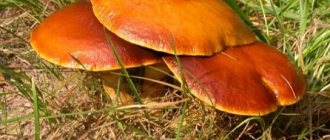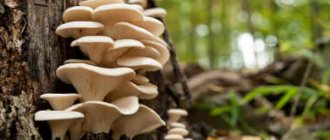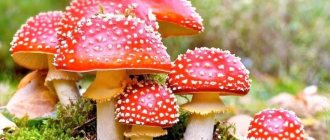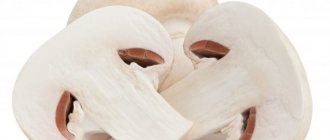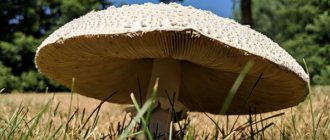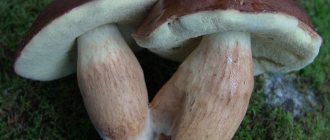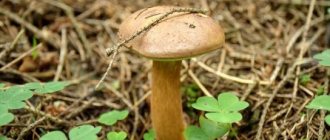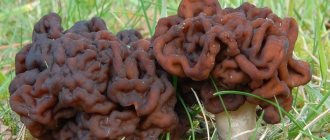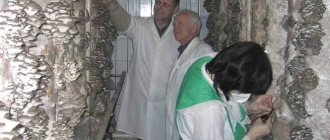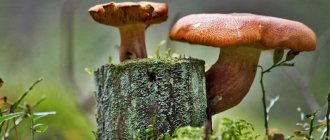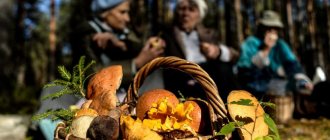Among the splendor of life created by nature, cap mushrooms occupy a special place, forming a unique kingdom of living organisms.
Several years ago, the study of mushrooms took place as part of the biology subject - in botany. However, later the opinion was established that mushrooms are neither plants nor animals.
So what is it? These are some living organisms in nature that occupy an intermediate position between flora and fauna.
Unlike plants, they do not have chlorophyll, cannot feed themselves through photosynthesis, and obtain organic matter directly from the soil by absorbing water along with inorganic matter or by penetrating into the roots of trees.
What mushrooms are called cap mushrooms?
The concept refers to a fruiting body with a “stem and cap” shape.
The representatives of this kingdom of living nature themselves are a plexus of thin plexuses of long branching threads called hyphae. You can examine them by slightly tearing the top layer of soil, litter or moss.
The collection of hyphae is called mycelium or mycelium.
The filaments consist of a single row of long elongated cells with one or more nuclei.
Most often, white hyphae are found, but they can be bluish, reddish, yellowish, sometimes olive-brown or other shades.
In the places where the fruiting bodies appear, dense glomerular plexuses of hyphae appear, capable of supporting a weight many times greater than a single thread.
The structure of cap mushrooms
Fruiting bodies consist of a large number of threads, tightly adjacent to one another, intertwined with each other.
The cap contains two layers, the upper of which is covered with skin, and the lower part consists of many thin small tubes or plates.
The types of the lower layer determined the names of the subgroups: tubular or lamellar.
The diagram shows the difference:
The captions show not only a schematic view of the lower part, but also some representatives that define the corresponding class.
Artificial cultivation
In terms of cultivation and artificial cultivation of mushrooms: for many tubular mushrooms this seems unlikely. Since they exist only in symbiosis with certain trees. Thus, to breed, for example, boletus on an industrial scale, you will need to plant an entire birch grove. But the cultivation of some lamellar plants is not only possible, but has also been successfully used by people for several centuries. Thus, the experience of people breeding champignons goes back up to 300 years. And the now popular oyster mushroom is grown in damp basements with great success.
Lamellar mushrooms
Russulas, milk mushrooms, mushrooms, mushrooms, champignons
They have caps that look like a small accordion from thin plates from below. These are lamellar mushrooms.
When determining them, an important role is played by the frequency of the plates per square centimeter, width, thickness and color.
No less significant are the methods and forms of attachment to the leg (in the center, side, edge).
Varieties of caps and legs
The external structure of the legs and caps may be different. In general, these parts of the mushroom are soft and fleshy, rotting after ripening.
Hats can be:
ovoid, hemispherical, convex, concave, flat.
Their edges are also varied:
wavy, smooth, dissected, bent, raised, lowered.
The legs are also not alike. They are found with or without a root-like appendage, obclavate, tuberous, cylindrical, narrowed.
Nutrition
Since fungi, unlike plants, do not have chloroplasts and other plastids, they cannot obtain food through photosynthesis.
They acquire organic and inorganic substances useful for growth and development by absorbing water from the soil by the mycelium.
Often, hyphae penetrate the roots of trees, receiving organic elements from plants, giving back water and minerals taken from the soil. This union of fungi and plants is called mycorrhiza.
How to choose a substrate?
Choosing a substrate - the material in which mushrooms will grow - is not an easy task. Firstly, it must be ideal for growing a specific type of mushroom - oyster mushrooms, champignons, porcini mushrooms, etc. Some species require a soft substrate, others prefer to grow on hard wood.
There are several substrate options; the mushroom grower’s task is to choose the best option for specific mushrooms and goals.
From straw
Use rye, wheat or oat straw. This is a cheap and accessible material. And most importantly, it is universal - almost any mushroom can be grown on straw. Mushrooms easily destroy and absorb the nutritional fibers of straw. The disadvantage of straw substrate is the need for sterilization (pasteurization). Any straw contains mold spores and other parasitic fungi that will compete with the cultivated fungus for food supply.
Log substrate
Mushrooms taste better on logs than on straw substrates. The mushroom takes a long time to grow into wood, but good harvests are obtained. Mushrooms are grown on deciduous wood - maple, poplar, willow, birch, chestnut, ash, and also on fruit trees. Not suitable - black walnut and white acacia. The nuances of growing on logs:
- Only healthy wood is used - without traces of other fungi.
- The presence of moss and lichen is allowed, but they are cleaned before sowing.
- It is best to cut down in late February to mid-March. At this time, sap flows through the tree. The mushrooms will receive an extremely nutritious environment.
- Log length – 50-150 cm. Diameter – 10-15 cm or more. Thin logs may break.
- A freshly cut log should sit for about six months before moving in. Logs should be stored in clean and ventilated areas. The tree should not come into contact with the ground.
- The ideal time to move in is spring, after frost. It is better not to sow in hot weather.
To grow on logs you will need:
- logs;
- 5/16 drill bit and drill;
- rubber hammer;
- work surface - for example, a workbench;
- natural wax;
- brush - apply wax;
- mushroom sticks.
Sawdust
The best sawdust for growing mushrooms is from deciduous trees. The choice is made like logs. You cannot use sawdust that is too small - it can become compressed and the mycelium will suffocate.
Pure sawdust has few nutrients. To increase nutritional value, bran is added to sawdust - they receive nitrogen. On empty sawdust, fungi grow thin, flimsy, with poorly developed caps. The sawdust is pasteurized before use.
Alternative substrates
In addition to logs, straw and sawdust substrates, you can use:
- sleepy coffee grounds;
- sleeping tea leaf;
- cardboard (without dyes);
- compost, garden waste;
- paper (if newspapers are used, you need to make sure the ink is non-toxic);
- sunflower husks, corn cobs, other organics.
The substrate is selected taking into account the type of fungus and the type of mycelium. If you bought mushroom sticks, then wood will serve as the substrate. You can also use straw, but in wood the mycelium, which is already familiar with the wood fibers, will germinate faster.
Reproduction
The functions of cap mushrooms are reduced to the reproduction of myceliums.
Small and light spores are formed in the tubes and plates of the lower layer of the cap. Each of them is a fungal cell.
They fall to the ground, are carried by the winds, enter the stomachs of animals without being digested, and are released along with the droppings. Thanks to this method of distribution, many mushrooms arise at great distances from the fruiting bodies.
Under favorable conditions, the spores germinate, gradually forming a mycelium.
After some time, new fruiting bodies begin to appear.
One cap mushroom can produce many millions of spores.
Tubular
There are just under 250 species of them in nature. They are found everywhere in temperate latitudes of various countries on the planet. They have a cushion-shaped cap, round in shape and fleshy. The tubular layer of the cap is quite easy to peel off. It is known that many tubulars enter into symbiosis with higher plants - trees of a certain type. Almost all tubular ones are edible. The most famous are: white boletus, boletus, boletus, moss mushroom, boletus. Some of the tubular ones also contain antibiotics that can kill pathogens.
Features of life
New myceliums appear in places with a large layer of humus, as well as next to the corresponding trees.
Different types of mushrooms are “friends” with certain types of trees
, near which they are grouped.
The appearance of fruiting bodies in different species does not occur simultaneously. Dry weather is not favorable.
The most conducive to the appearance of fruiting bodies is a uniform change of heat and coolness, bringing light rains. Early cold snaps also stop growth.
Edible cap mushrooms
There is a table showing which mushrooms can be eaten.
Examples of edible mushrooms:
- boletus;
- saffron milk caps;
- boletus;
- Russula;
- white;
- chanterelles;
- milk mushrooms;
- flywheels and many others.
Among them there are mushrooms of different types and structures.
Kinds
There are 3 types, which are divided into edible and conditionally edible.
Tubular
Tubular mushrooms are distinguished by the structure of their cap, which has a porous structure resembling a sponge. The inner part is permeated with a large number of small tubes intertwined with each other. Mushrooms of this type can usually be found in the shade of trees, where there is little sunlight, damp and cool.
Among tubular mushrooms, both edible and conditionally edible ones are common. Their fruits are very fleshy and have high nutritional value.
Among the edible tubular mushrooms there are many poisonous look-alikes. For example, a safe porcini mushroom can be confused with an inedible gall mushroom. Before picking, you should carefully study the characteristics of edible fruits.
Most popular edibles
Below are tubular mushrooms that can be eaten without any precautions:
1 Porcini mushroom or boletus
The porcini mushroom is the most famous representative of tubular mushrooms. If you pay attention to the cap, you will notice that it is slightly convex in shape, soft brown in color, with light areas. The inner side of the cap is permeated with white or yellowish pores, depending on the age of the mushroom, with a mesh structure. The pulp is white, fleshy, juicy, and has a mild taste. When cooked and dried, a rich mushroom smell appears. The leg is thick, brown in color.
Mushroom pickers advise looking for boletus in forests, in the shade of pine or birch trees. The best time to collect is from June to September.
2Maslyata
The cap is conical, brown, and oily to the touch due to the mucus covering it. The inside of the cap is yellowish; in early mushrooms it is covered with a light mesh, which breaks through over time. The pulp is tender and light, closer to the stem it has a brownish tint. The leg is thin, light yellow.
Butterflies usually grow in families. They can be found in the pine forest from July to September.
3Moss fly
The color of the cap can be light brown or soft green, with a yellow interior. When the flesh is cut, the flywheel turns blue, but it is not poisonous. The leg is dense, from 4 to 8 cm in height.
The mushroom grows in the forest, in loose soil, and is sometimes found near swamps. The optimal time for the Moss Cathedral is considered to be from July to October.
4Boletus
It is distinguished by a convex wide cap of orange-red color. The pulp is porous, light, but when broken it becomes darker. The leg is dense, narrowed at the top, covered with dark scales.
You can find the mushroom in a mixed forest, under aspens or near pine trees. Productivity is observed from August to September.
5Common boletus
The gray-brown cap has the shape of a semicircle. The lower part is light and soft to the touch. The flesh is white, but darkens during cooking. The leg is long, white, covered with dark scales.
It is recommended to collect young mushrooms. They should be cooked or dried immediately, as boletus mushrooms spoil quickly.
The mushroom grows in families under birch trees. Collection time is June-September.
6Polish mushroom
Similar to boletus. Has a brown cap. The pulp has wide pores, is pale yellow, and darkens when cut. The leg is light brown, with a barely noticeable striped pattern.
When wet, the skin of the mushroom is more difficult to separate.
Often found under pine trees, on loose soils. You can go on a quiet hunt for the Polish mushroom from July to October, inclusive.
7Boletin
The cap has a matte surface and has thin scales. There may be color variation from brown to yellowish. The pulp is yellow and has a pronounced mushroom smell. The leg is brown. In early mushrooms you can see a yellowish ring on the stem.
Can be found in forests, particularly mixed or deciduous ones. They are usually collected from August to October.
8Bruise
This mushroom is the rarest of those presented. It has a wide flat cap, slightly concave at the edges. The surface of the cap is dry, grayish-brown in color. When pressed, it acquires a blue tint. The pulp has a brittle structure, cream color, but when broken it becomes cornflower blue. It has a delicate taste and smell. The leg is long, thick at the base.
Some mushroom pickers mistake the mushroom for being poisonous due to its ability to change color. However, it is not poisonous and tastes quite pleasant.
Most often seen in deciduous forests, between July and September.
The most popular conditionally edible
Special attention should be paid to conditionally edible mushrooms. There are quite a lot of them among tubular mushrooms. The most common ones are described below.
1Dubovik olive-brown
The caps are large and brown. The internal structure is porous and changes color over time from yellowish to dark orange. When broken, the color darkens. The leg is full, brown, covered with a reddish mesh. Used pickled.
Usually grow near oak forests. Oak trees are collected from July to September.
2 Speckled oakweed
It has a wide hat, the shape of which is something like a semicircle. The color generally varies from brown to brown-black. The surface of the cap is velvety to the touch and becomes darker when pressed. The flesh is red-brown in color and changes color to blue when broken. Has no smell. The leg is tall, thick, and you can see thin scales on it. Speckled oakberry is eaten only after boiling.
Can be found in forests - both coniferous and deciduous. It produces a harvest from May to October. Peak fruiting occurs in July.
Read more about oak trees here.
3Chestnut mushroom
The hat has a round shape and is brown in color. Young mushrooms have a velvety surface to the touch, while older ones, on the contrary, are smooth. The pulp is white in color. Has a faint smell of hazelnut. The stem is similar in color to the cap, thinner at the top than at the bottom. The mushroom must be dried before eating.
Found near deciduous trees from July to September.
4Kozlyak
The cap of this mushroom is most often flattened. The color is reddish-red-brown. The skin is difficult to separate from the cap. The pulp is dense, elastic, pale yellow in color. Turns pink when cut. After cooking, the mushroom turns pinkish-purple in color. The leg is tall, cylindrical, usually curved. The color of the stem is similar to the cap. Most often they are boiled before eating, salted or pickled.
Can be found near the pine trees. Distributed from August to September.
5Pepper mushroom
The hat is round and convex. It flattens over time. The color is yellow-brown or red-brown. May become sticky when wet. The pulp is fragile, yellow in color. It has a distinct pungent taste. These mushrooms have a short, moderately thin stem. The color of the stem is almost the same as that of the cap, but lighter.
The mushroom is used in powdered seasoning form as a substitute for pepper. It cannot be eaten in any other form.
Pepper mushroom can be found in coniferous forests. It is most often harvested from July to October.
Lamellar
Lamellar mushrooms are called because of the cap, the inside of which is permeated with thin plates containing spores for reproduction. They stretch from the center to the edges of the cap along the entire inner surface of the mushroom.
Lamellar mushrooms are the most common and well-known type of mushroom. Quiet hunting for mushrooms of this species lasts from mid-summer to early winter. They can grow in both deciduous and coniferous forests.
Most popular edibles
The most famous of the edible agaric mushrooms are given in this list:
1 Chanterelle
It is distinguished by a concave cap with curved edges, the color of the cap is yellow-orange. The pulp is a delicate yellow color; if you touch it, you will find that the structure is quite dense. The chanterelle's leg has the same color as the cap and continues it.
Distributed in deciduous and coniferous forests. It is necessary to collect from July to October.
Chanterelles have poisonous counterparts. You should pay attention to the color of the cap; in harmful mushrooms it is usually light yellow or pinkish.
2Ryzhik
The cap is covered with rings and may be concave towards the middle. Has a light orange color. The pulp is also almost orange in color and has a dense structure. The leg is small, identical in color to the cap.
You can find it in coniferous forests, under pine trees. Collected from July to October.
3 Autumn honey fungus
The cap is convex, covered with thin scales. The color ranges from honey to soft green-brown. The pulp has a dense structure and is light. Attractive with its delicate scent. The legs are narrow, pale yellow, darker towards the bottom, with a small ring under the cap.
Can be found in deciduous forests, on woody surfaces. It is recommended to look for honey mushrooms from September to November.
The honey fungus also has a dangerous double - the false honey fungus. Its differences lie in the absence of a ring on the stem, its color is olive or almost black, more saturated.
We recommend reading the article about growing honey mushrooms on your farm - here.
4 Russula
In young mushrooms, the caps are shaped like a hemisphere, while in older ones they become flat. Differs in light brown, pink-brown, pink color. The inner side is fragile, whitish, becoming darker with age. The leg has a cylindrical shape, it can be dense or hollow inside, which depends on the variety.
You can see russula in mixed forests, from June to November.
5May mushroom
The hat has a convex shape and is cream-colored. The inner side is white, with a dense structure. It tastes like flour. The leg is long, white, with an orange tint visible at the base.
Grows in meadows and pastures. Fruiting time is from April to June.
6Ringed cap
The cap of this mushroom is shaped like a cap, which is why it got its name. It has a warm, soft yellow color, sometimes close to ocher, with a striped pattern. The inside is soft, slightly yellowish in color. The leg is strong and long.
Can be found mainly under coniferous trees, sometimes under birch or oak. They are usually collected between July and October.
7 Mokrukha felt
The shape of the cap is dome-like and has a yellow-brown tint. The pulp is ocher color. The stalk is elongated, in earlier mushrooms it is covered with a white network.
Distributed in coniferous forests. Collected from June to October.
8 Honeycomb-shaped row
The hat is convex in shape. The surface is fibrous and the color varies from red to orange-yellow. The pulp is white, with thick plates. The leg is cone-shaped, white, covered with reddish scales. It is recommended to eat only fresh.
You can find it under the pine trees, from March to November.
9Champignon
It has a round cap with the edges turned inward, white or brownish in color, and opens up as the mushroom ages. The pulp is light, and over time changes its color to gray. The leg is low, light, dense in structure. When cooked, mushrooms darken. They have a distinct mushroom smell.
They grow in mixed forests or meadows. It is recommended to collect from June to September.
10Oyster mushroom
The hat is ear-shaped and has curved edges. Usually light or soft gray in color. Has a smooth surface. The leg is short, thin, white. The pulp has wide plates, white or pale yellow. They do not have a pronounced odor. It is recommended to eat them young, since old mushrooms have a rigid structure.
They belong to the oyster mushrooms and usually grow in families on trees or rotten stumps. It can usually be harvested in warm weather from August to September.
Champignons and oyster mushrooms are cultivated mushrooms. They are bred in artificial conditions for consumption. They can most often be found on the shelves of shops and supermarkets. Oyster mushrooms can be frozen.
